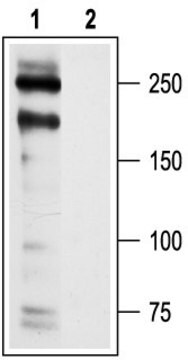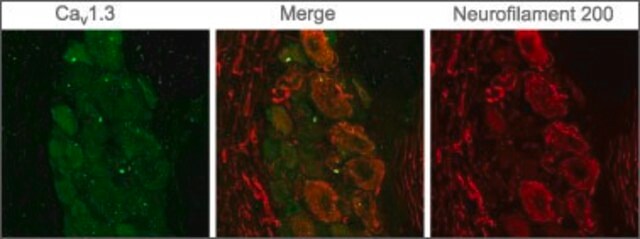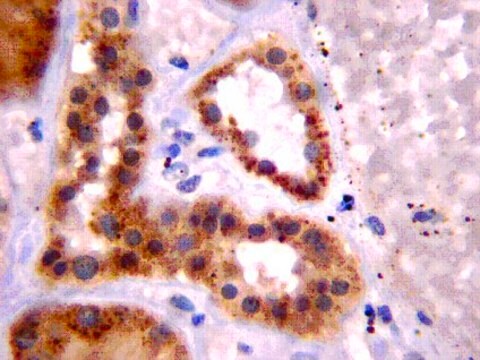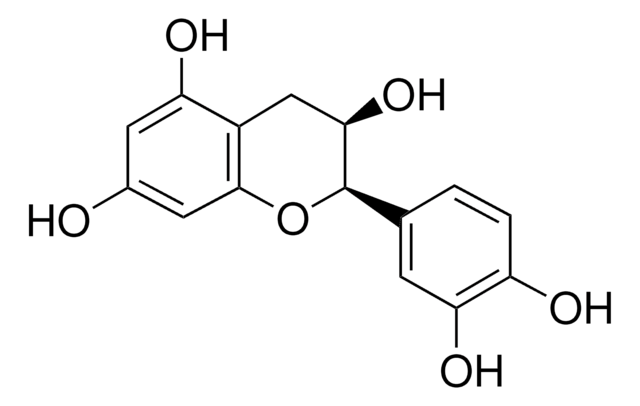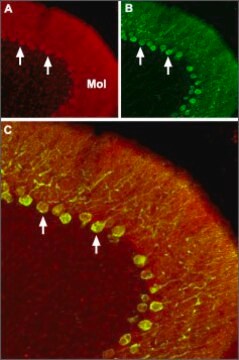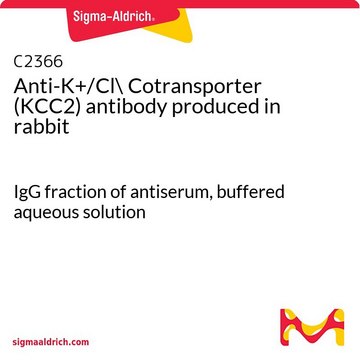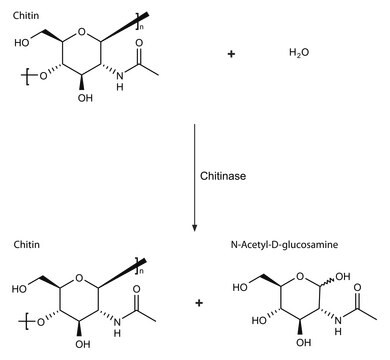C1603
Anti-Calcium Channel (α1C Subunit) (L-type of Voltage-gated Ca2+ Channel) antibody produced in rabbit
affinity isolated antibody
동의어(들):
Anti-CACH2, Anti-CACN2, Anti-CACNL1A1, Anti-CCHL1A1, Anti-CaV1.2, Anti-LQT8, Anti-TS, Anti-TS. LQT8
로그인조직 및 계약 가격 보기
모든 사진(3)
About This Item
결합:
unconjugated
application:
IHC
WB
WB
클론:
polyclonal
종 반응성:
human, rat, mouse, rabbit
citations:
14
기술:
immunohistochemistry: suitable using Rat brain sections
western blot: 1:200 using Rat brain and rat heart membranes
western blot: 1:200 using Rat brain and rat heart membranes
추천 제품
생물학적 소스
rabbit
Quality Level
결합
unconjugated
항체 형태
affinity isolated antibody
항체 생산 유형
primary antibodies
클론
polyclonal
종 반응성
human, rat, mouse, rabbit
기술
immunohistochemistry: suitable using Rat brain sections
western blot: 1:200 using Rat brain and rat heart membranes
UniProt 수납 번호
저장 온도
−20°C
타겟 번역 후 변형
unmodified
유전자 정보
mouse ... Cacna1c(12288)
일반 설명
L-type of Voltage-gated Ca2+ Channels (L-type VGCC) is a high voltage-activated channel that exerts spatial and temporal control over cellular calcium concentrations and modulates function such as neurotransmitter release, hormone secretion, muscle contraction, electrical activity, cell metabolism and proliferation, gene expression and neuronal survival. Calcium dependent processes are important in synaptic modification and thus alterations in calcium channel function may be important for both modifying synaptic plasticity and also in age-related neurodegenerative diseases. Calcium channel antagonists are used as antiarrhythmics and in the treatment of hypertension and may even be neuroprotective in Parkinson′s Disease. Calcium Channel α1C subunit is a pore-forming subunit that together with β subunits generates the necessary signal for membrane targeting of class C L-type calcium channels.
특이성
Anti-Voltage-gated Calcium Channel α1C subunit recognizes the α1C subunit by immunoblotting in rat brain and rat heart membranes. Reactivity has been confirmed for rat, mouse, rabbit and human.
면역원
synthetic peptide corresponding to amino acids 848 to 865 of rat α1C.
애플리케이션
Anti-Calcium Channel (α1C Subunit) (L-type of Voltage-gated Ca2+ Channel) antibody produced in rabbit has been used in:
- SDS-PAGE
- western blotting
- coimmunoprecipitation
Applications in which this antibody has been used successfully, and the associated peer-reviewed papers, are given below.
Immunohistochemistry (1 paper)
Immunohistochemistry (1 paper)
Rabbit polyclonal anti-Calcium Channel α1C subunit antibody is used to tag class C L-type calcium channel subunit α1C for detection and quantitation by immunocytochemical and immunohistochemical (IHC) techniques such as ELISA, immunoblotting, and immunoprecipitation. It is used as a probe to determine the presence and roles of calcium channel subunit α1C in class C L-type voltage-gated Ca2+ channel subunit complexes.
물리적 형태
Lyophilized from phosphate buffered saline, pH 7.4, containing 1% bovine serum albumin and 0.05% sodium azide.
면책조항
Unless otherwise stated in our catalog or other company documentation accompanying the product(s), our products are intended for research use only and are not to be used for any other purpose, which includes but is not limited to, unauthorized commercial uses, in vitro diagnostic uses, ex vivo or in vivo therapeutic uses or any type of consumption or application to humans or animals.
적합한 제품을 찾을 수 없으신가요?
당사의 제품 선택기 도구.을(를) 시도해 보세요.
Storage Class Code
10 - Combustible liquids
WGK
WGK 3
Flash Point (°F)
Not applicable
Flash Point (°C)
Not applicable
이미 열람한 고객
Functional coupling of the metabotropic glutamate receptor, InsP3 receptor and L-type Ca2+ channel in mouse CA1 pyramidal cells
Kato HK, et al.
The Journal of Physiology, 590(13), 3019-3034 (2012)
A S Axelsson et al.
Nature communications, 8, 15652-15652 (2017-06-07)
Type 2 diabetes (T2D) is characterized by insulin resistance and impaired insulin secretion, but the mechanisms underlying insulin secretion failure are not completely understood. Here, we show that a set of co-expressed genes, which is enriched for genes with islet-selective
Calcium channel function and regulation in beta1-and beta2-adrenoceptor transgenic mice
Foerster K, et al.
Naunyn-Schmiedeberg'S Archives of Pharmacology, 369(5), 490-495 (2004)
Nina Daschil et al.
Pharmacology, 93(1-2), 24-31 (2014-01-18)
It is well established that reactive astrocytes express L-type calcium channels (LTCC), but their functional role is completely unknown. We have recently shown that reactive astrocytes highly express the CaV1.2 α1-subunit around β-amyloid (Aβ) plaques in an Alzheimer mouse model.
Jing Liu et al.
American journal of physiology. Cell physiology, 297(1), C152-C159 (2009-04-10)
Cardiomyocytes (CMs) are nonregenerative. Self-renewable pluripotent human embryonic stem cells (hESCs) can differentiate into CMs for cell-based therapies. We recently reported that Ca(2+) handling, crucial to excitation-contraction coupling of hESC-derived CMs (hESC-CMs), is functional but immature. Such immature properties as
자사의 과학자팀은 생명 과학, 재료 과학, 화학 합성, 크로마토그래피, 분석 및 기타 많은 영역을 포함한 모든 과학 분야에 경험이 있습니다..
고객지원팀으로 연락바랍니다.